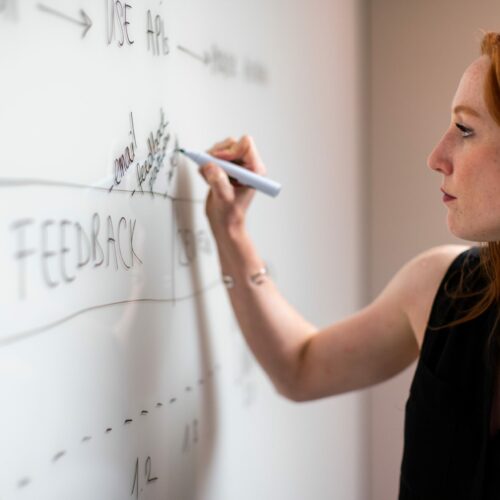What do you think of when I say the word ‘chair’?
Chances are that you think of the basic construct of a chair – legs, a seated platform, and a back. But beyond that what you imagine and what I imagine could be completely different. You may be thinking of a padded chair, more like a sofa, whereas I could be thinking of a rocking chair. Or you could be thinking of an office chair and me a garden chair. Or you a stiff, wooden school chair and me a designer, Barcelona chair.
The point is that even a comparatively simple concept like a chair can be thought of completely differently depending upon our context, experiences and preferences. So, imagine how different our perceptions of something more complex are, like a shop or an airport or a city. But actually, even these are relatively similar, as we all know the basic functions of a shop, for example. We’ve been in one before, we know what to expect inside. Our mental projections will have some similarities. How about something novel, that no one has seen before – like a new product, or a new service. We would all have a different mental projection of what that looks like.
Have you ever sat in a meeting, discussing a proposal or a project or an idea, and you are confident that everyone imagines things the way you do – I mean how could they not? – only for hours or days or weeks later, when you see their projections brought to life it’s completely different.
“Have you ever sat in a meeting, discussing a proposal or a project or an idea, and you are confident that everyone imagines things the way you do – I mean how could they not?”
I know I certainly have. Internal meetings over how to design a project; client meetings on a particular methodology or set up; design meetings on a new piece of creative. All have fallen foul of talking at cross-purposes. And I don’t believe I’m the only one.
The problem is that we are the only ones who can see our mind’s eye’s projections. So, no one else can relate to our mental image. This is what psychologists refer to as our individual remote memory, because our memories and mental images are individual and locked away from anyone else, remote.
The question is then, how do we overcome this barrier and make our mental images less remote. One solution is displayed thinking. A term coined by Mike Vance, who led Disney’s Ideas and People Development for Disney Productions, Disneyland and Walt Disney World in the 1970s. He was inspired by the motion picture technique of storyboarding and modified it to for group discussion.
At its core, displayed thinking can be thought of as any discussion with two or more people where ideas are captured visually, rather than just discussed. The key though, is that they are displayed for all to see, not hidden in individual notebooks or laptops. Whiteboards, flipcharts, corkboards, and blackboards are all great resources for displayed thinking, allowing you to easily show your thinking and ideas to others.
In this way, you are moving your ideas from your own individual remote memory and creating a shared direct memory. A living, growing memory of the discussion which can be directly accessed by all just by looking at it.
Displayed thinking has 7 clear benefits. It is:
- Contextual. By seeing ideas arranged visually you get an immediate sense of their place in time, in size, and in relation to other objects. A lot more information than just the idea itself.
- Inspirational. When visually depicted, ideas are more able inspire new ones. You can build off others’ thoughts and more quickly enrich the conversation.
- Editable. Ideas can be more precisely edited. For example, a line on a whiteboard can be re-drawn longer, or shorter or closer to something else. The same idea edited and refined with shared understanding.
- Referential. It is easier to refer to a visual idea as this or that. So, relative references like, ‘let’s move this ahead of that’ come more naturally, rather than having to describe the whole idea, so more detailed discussions can be had.
- Constructive. Visual ideas are concrete and specific, not abstract and general. It’s much easier to have constructive conversations about specific ideas, generating richer more valuable and worthwhile discussion.
- Collaborative. Displayed thinking forces you away from your own thoughts and distractions like notebooks, phones and laptops. It also promotes eye contact, which fosters a greater collaboration, understanding and attention.
- Concrete. Displayed thinking is physically captured, meaning it doesn’t have to be remembered. Not only does this ease mental processing, but it also allows you to refer back to it at a later date. Where the previous ideas of displayed thinking can act as a knowledge base, inspiring new thoughts and avoiding re-visiting old discussions.
The longer I’ve been in my career, the more I’ve come to rely on and champion the benefits of displayed thinking as a fundamental tool of knowledge workers. In any internal meeting I go to now, I make sure there’s something to write on – a whiteboard or flipchart are ideal. At client meetings, I find myself spending more time at the whiteboard – drawing and discussing ideas – than sat down. I have a Surface laptop that has a pen accessory, which is ideal for spontaneous idea generation. And I even have a drawing app on my phone.
I hate losing ideas to the ether because they weren’t captured down, and I love being able to share my ideas in a visual, concrete way as I find the conversations are richer, quicker and more collaborative.
If you don’t already, I’d strongly recommend investing in some of the tools of displayed thinking and use them at your next meeting. And see how much better and effective your conversations become.




 Senior Marketing Executive
Senior Marketing Executive Sales & Marketing
Sales & Marketing General Manager PR -Internal Communications & Government Affairs
General Manager PR -Internal Communications & Government Affairs Vital Strategies
Vital Strategies
 Customer Intelligence Director
Customer Intelligence Director